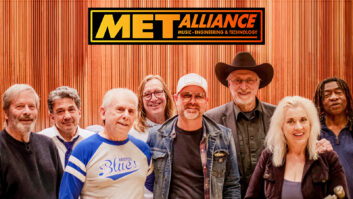After seeing the growth and then rapid decline of the music industry, our merry band of music makers felt the need to defend the art form we’ve all embraced. We had all previously heard the idea that mixing audio for TV didn’t matter, because people heard it on 1” speakers. MP3 offered a similar argument: who cared—and importantly, who would pay for anything better?
We didn’t agree, and simply asking the artist only reinforced the mission. They want everyone to hear what they hear in their ears, hearts and soul, not some compromised rendition. Our argument was simply put: If you’d pay a few dollars for a cup of coffee that might last you 10 minutes, why wouldn’t you pay a few dollars for a recording that offered you the fullest, most rich experience that could last you a lifetime?
The METAlliance Report: Grid Versus Groove
The METAlliance Report: Ed Cherney (1950-2019)—Someone Truly Special
The METAlliance Report: How to Choose Your Next Studio Monitors
We started with educators—the real ones, not those entities looking to profit off someone’s passion and only provide them with a limited and often inferior schooling. We talked with, visited and supported their efforts. The love of music hasn’t abated; the thirst for how to make music has grown substantially. The number of accredited institutions offering audio programs seems to increase by the year. Music schools often offer an engineering track. The idea is that when understood, quality in audio retains or even gains value. The goal then was to increase understanding, and teaching institutions are a fundamental avenue towards that end.
We also started our “In Session” weekends in Los Angeles and New York City, recording real artists in real session dates. These were meant to offer those interested an opportunity to see how the people who did this (as they have for decades) applied their mainstream methodology of capturing a group of players and singers, and the magic that can result. We included techniques for In-The-Box work and also mixing. It also became clear that in addition to students, many professionals attended so as hone their skills and just hang with our group of accomplished characters and musicians. These are complicated to arrange and manage, and even with support from key people, studios and manufacturers, are never anything profitable, but they are always fun and genuinely rewarding.
It wasn’t remarkable that the METAlliance members all learned, too. The attendees with the shared “audio affliction” all had ideas and methods to contribute—not only on the audio side, but also how they succeeded in maintaining their vocation in often difficult situations. They were often equally thankful and inspiring. You could see them all relate to the late Ed Cherney’s story in the early days of being fired for the first time.
It still continues: Al Schmitt tells a great tale how his first time in the engineering seat was both a thrill and truly scary. I remember how I had to literally invent a technology improvement to make a talented artist happy. Chuck Ainlay recalls how he moved from a small town in Indiana to Nashville to make a career based on confidence and passion. Elliot Scheiner teaches how he mixes, and we’ve seen an attendee literally put his face on the faders to watch Els’ most minute fader moves on a lead vocal. Frank Filipetti recounts building perhaps the first end-to-end digital recording process for a major artist’s record in a house, and it proved to be award-worthy. And of course, the late great Phil Ramone used to share how he finally got work with Sinatra. These are the stories of an art form. These are memories born of the magic of collaboration, attention to the art and science, and most of all, in service to the music.
Today, people still listen to music all the time. It may be through earbuds that hopefully do the music justice, and are perhaps the only way people can actually focus on what they’re hearing through this media onslaught we all live in day-to-day. Those listeners hear it exactly how you produced it, but they probably haven’t given that a thought. You know it’s happened, though, when people still have a song running through their heads. The emotional contact is real and universal.
In the end, when it comes to standing up for quality and not just convenience, when the dollars don’t always justify the result financially but they do artistically, when someone insists “it’s not worth it, nobody cares,” that’s when someone needs to suggest otherwise. If we don’t support each other, what should we expect from the rest of the world?
If not us—and you—then who, right?
Grammy and TEC Award-winner George Massenburg is a producer, recording engineer and designer of audio equipment who has participated in the creation of more than 400 albums. He has won Grammys as both a producer and as an engineer, and in 1998, was awarded a Grammy for Technical Achievement for a lifetime of contributions to the art and science of recording. Massenburg’s discography includes seven Little Feat albums; seven Earth, Wind & Fire albums; 13 Linda Ronstadt albums; and albums with Journey, James Taylor, Jennifer Warnes, Herbie Hancock and Ricky Skaggs, among others. He also created that mainstay of the recording process, the Parametric Equalizer.
METAlliance • www.metalliance.com
THE METALLIANCE: Al Schmitt, Chuck Ainlay, Elliot Scheiner, Frank Filipetti and George Massenburg, along with the late Phil Ramone and Ed Cherney, founded The METAlliance with the dual purpose of mentoring through “In Session” educational events and to convey to the audio professional and semi-professional the group’s choices for the highest quality hardware and software, by shining a light on products worthy of consideration through a certification process and product reviews in this column. The METAlliance Mission—to promote the highest quality in the art and science of recording music.







